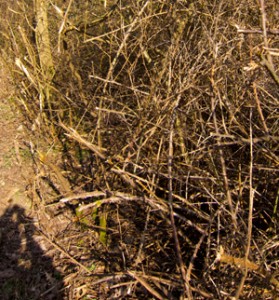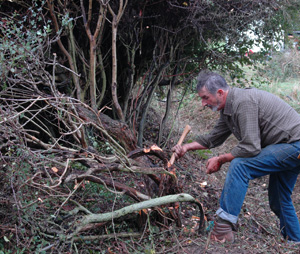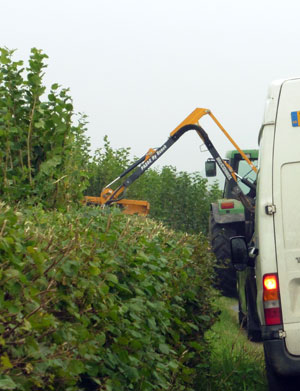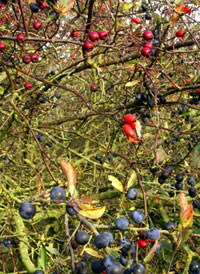Hedges revisited …….

The work of Max Hooper established that not all hedges are ‘equal’ – they vary considerably in terms of their age and composition. Many thought of hedges as products of the Enclosure Acts of the C18th and C19th, that is, they were added to the landscape in these times - but many hedges / hedgerows (representing various boundaries) date back many centuries. There are significant differences between truly ‘ancient’ hedges and those established in more recent times.
Ancient hedges are generally species rich – in terms of the species in the herb, shrub and tree layers, and consequently rich in associated birds and insects. Ancient hedges are often associated with natural features or boundaries (streams, valley bottoms, tracks or estate boundaries). Boundary hedges often stand on raised banks and offer refuges / micro-habitats for many insects, for example, solitary bees. Solitary bees make their nests in the ground – often in sandy or well draining soil. The female will create a nest, stock it with pollen, nectar and fertilised eggs and then seal it up – leaving the young to develop. There are some 200 species of solitary bees in the U.K. and they have an important role in the pollination of both wild (e.g. clover) and cultivated plants (e.g. fruit trees).
 The hedges from the C18th and C19th were often created using hawthorn, blackthorn and sometimes elm; the flowers found in them are more typical of fields. It is these hedges that have suffered particularly over the last fifty years with the advance of mechanised farming – many were removed to create larger fields. Whilst it can be argued that hedges offer crops protection as windbreaks, they also ‘cut out’ light / sun locally; and whilst they may harbour insect eating birds, which remove aphids etc. hedgerows may also harbour weeds and / or fungal pathogens.
The hedges from the C18th and C19th were often created using hawthorn, blackthorn and sometimes elm; the flowers found in them are more typical of fields. It is these hedges that have suffered particularly over the last fifty years with the advance of mechanised farming – many were removed to create larger fields. Whilst it can be argued that hedges offer crops protection as windbreaks, they also ‘cut out’ light / sun locally; and whilst they may harbour insect eating birds, which remove aphids etc. hedgerows may also harbour weeds and / or fungal pathogens.
One problem with all hedges – ancient or ‘modern’ is that they require maintenance. If they are near a field, track or road then the trees or shrubs can begin to encroach on this space. In the past, hedges / hedgerows were maintained by hand through traditional crafts / skills e.g. hedge layering / pleaching (often demonstrated at Wood Fairs). http://www.youtube.com/watch?v=Andv7a0NPEc .
 But such an approach is very time consuming and therefore costly – so many land owners resort to other means, such as the use of flail mowers. Ideally, a flail cutter should trim a hedge to an A shape – with two sweeps of the cutter. This allows the hedge to be broad and bushy at the base – offering nesting sites for birds and refuges / habitats for small mammals and insects. If done with consideration, flailing can be an effective means of maintaining a healthy and diverse hedge but if the flail sweeps back and forth then young trees are lost - as is the shape and form of the hedge (featured image above).
But such an approach is very time consuming and therefore costly – so many land owners resort to other means, such as the use of flail mowers. Ideally, a flail cutter should trim a hedge to an A shape – with two sweeps of the cutter. This allows the hedge to be broad and bushy at the base – offering nesting sites for birds and refuges / habitats for small mammals and insects. If done with consideration, flailing can be an effective means of maintaining a healthy and diverse hedge but if the flail sweeps back and forth then young trees are lost - as is the shape and form of the hedge (featured image above).
Over the last 4 / 5 decades, we have lost many hedges / hedgerows (perhaps a quarter or more – during what Rackham has termed “the locust years”) and many trees have been lost through the destruction of hedgerows or through disease – for example, the loss of millions of elm trees through the spread of Dutch Elm Disease. Schemes exist to replace and add to the trees in our current landscape, for example, the creation of the National Forest and the Big Tree Plant (launched by DEFRA and the Forestry Commission in 2010). 
There are also local schemes, for example, The East Midlands Local Trees Initiative which seeks to promote the planting of trees but also to encourage the use of local stock and seed, rather the imports from continental Europe. Imported stock has a significant carbon footprint due to the distances moved and can be a source of pathogens. Local stock also offers better chance of establishment and growth of young trees, and these tend to come into flower and fruit in synchrony with local bird, mammal and insect populations.
Anyone interested in learning more about using local derived stock and the best practice in restoring habitats in town and countryside might be interested in visiting http://www.floralocale.org/HomePage - who provide training and information.
Comments are closed for this post.
Discussion
A most interesting article and as someone who is undertaking Hedgerow Bird surveys, I can relate to the above observations. In fact, much of our wildlife depends on hedgerows for cover, nesting or even as a simple roost away from inclement weather. I have witnessed the most unlikely of bird species using them, for example, Skylarks. And then, there are the Butterflies which will fly into them, presumably laying eggs. There are quite a few blog posts out there and I especially liked the following post.
Kind Regards
Tony

Interesting blog Tony, thanks.
Good to see some properly laid hedges rather than the tractor mutilated ones that seem to be all too common around me.
Giles
7 May, 2013